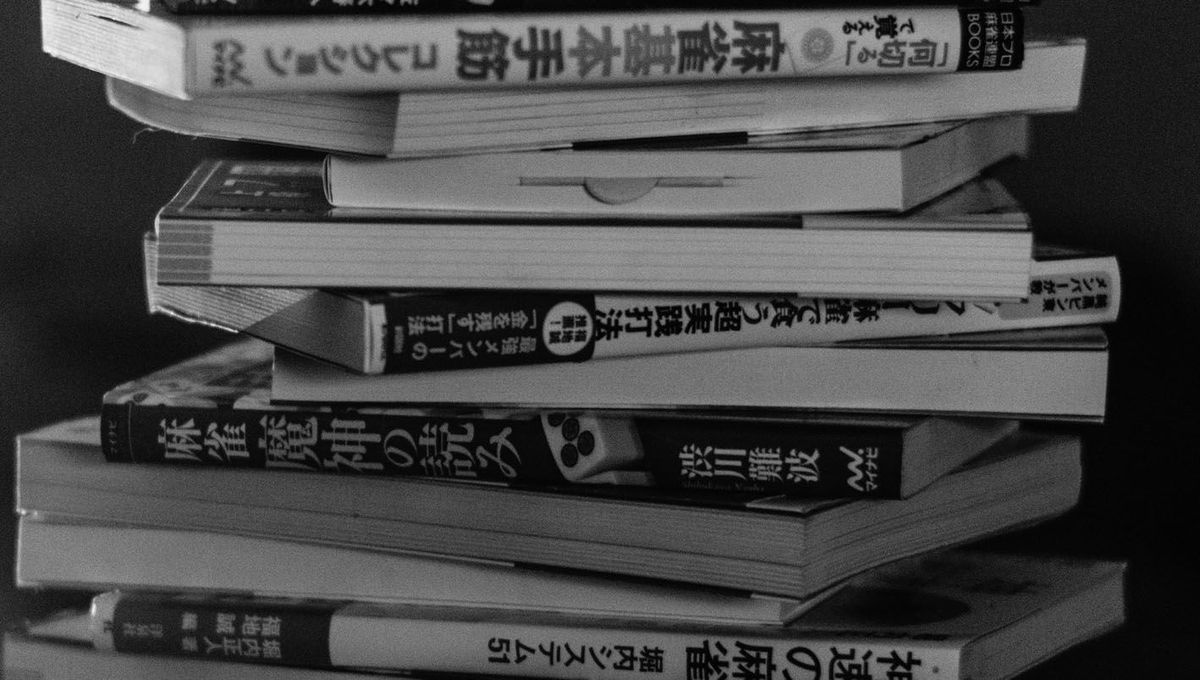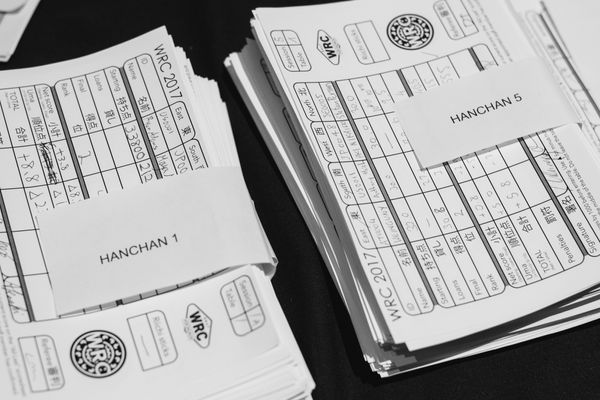Defense Guide part 2: Kabe, Saki-giri, and Dama-ten

Here's another basic Mahjong strategy known as Kabe, plus Dama-ten and Saki-giri which you can use against slightly tougher opponents.
Yo, this is UmaiKeiki again. If you are reading this, it means I actually made more of my defense guide (a surprise, I know). This is a continuation of my previous post which you should probably read first. I apologize if this turns into another novel/tl;dr/wall of text/whatever.
Kabe
While Suji represent information broadcast to everyone through discards, Kabe can often be privileged information gained from tiles in your own hand. "Kabe" translates as "wall", and that's exactly what they do: Kabe act as barriers that prevent shuntsu from being formed.A Kabe is formed when all four instances of a number tile are visible. They can be in discards, in open melds, as Dora indicators, or in your hand. The more instances of the tile you have in your hand, the more of an advantage you have over opponents. For all they know, those tiles could still be available in the walls and they may try (unsuccessfully) to build shuntsu around them.
Kabe are great for identifying safe tiles during Betaori. Let's suppose all four ![]() are visible to you. That means nobody can have a shuntsu containing it (although, it could still be a waiting tile). Since there are no shuntsu containing it, then you know that
are visible to you. That means nobody can have a shuntsu containing it (although, it could still be a waiting tile). Since there are no shuntsu containing it, then you know that ![]() and
and ![]() can not possibly complete any Ryanmen waits! The only waits on those two tiles can be Shanpon and Tanki.
can not possibly complete any Ryanmen waits! The only waits on those two tiles can be Shanpon and Tanki.
Now let's say you have a Kabe on ![]() . This blocks three shuntsu:
. This blocks three shuntsu: ![]()
![]()
![]() ,
, ![]()
![]()
![]() , and
, and ![]()
![]()
![]() . Now it would still be possible for someone to have a
. Now it would still be possible for someone to have a ![]()
![]() ,
, ![]()
![]() , or
, or ![]()
![]() Ryanmen wait, but it would be impossible for them to have a
Ryanmen wait, but it would be impossible for them to have a ![]()
![]() or
or ![]()
![]() wait. That makes
wait. That makes ![]() and
and ![]() safe against Ryanmen.
safe against Ryanmen.
Now consider a Kabe on ![]() . This makes
. This makes ![]()
![]() and
and ![]()
![]() Ryanmen waits impossible, but someone could still have
Ryanmen waits impossible, but someone could still have ![]()
![]() or
or ![]()
![]() waits. Thus, the safe tiles are
waits. Thus, the safe tiles are ![]() and
and ![]() .
.
By symmetry, we can show the following tiles are safe when we have a Kabe:
| Kabe | Safe tiles |
If there are one or two tiles sandwiched between the Kabe, both are safe. For example, if you have ![]() and
and ![]() Kabe, then
Kabe, then ![]() and
and ![]() are not usable for shuntsu -- and can thus only be Shanpon or Tanki waits.
are not usable for shuntsu -- and can thus only be Shanpon or Tanki waits.
And if you have a ![]() and
and ![]() Kabe, then the inner tile,
Kabe, then the inner tile, ![]() , is safe, but the
, is safe, but the ![]() and
and ![]() are still dangerous.
are still dangerous.
Naturally, Kabe are only reliable when you can see all 4 instances of a tile. When all 4 are visible, it's known as "No Chance"; if there are only three visible, it's called "One Chance". As you can imagine, One Chance Kabe aren't nearly as safe. If you can see three ![]() , for example, it's still not safe to throw a
, for example, it's still not safe to throw a ![]() because the opponent you are defending against could have
because the opponent you are defending against could have ![]()
![]() waiting on
waiting on ![]()
![]() . However, if it's a toss-up between discarding
. However, if it's a toss-up between discarding ![]() and
and ![]() , for example, it's somewhat safer to discard the
, for example, it's somewhat safer to discard the ![]() .
.
Of course, the existence of two One Chance Kabe is much better: if you can see three ![]() and three
and three ![]() then the
then the ![]() is mostly safe. However, it's not nearly as safe as it would be if there were a No Chance.
is mostly safe. However, it's not nearly as safe as it would be if there were a No Chance.
Even if you don't have the opportunity to use Kabe every time you defend, make sure you watch the discards so that your own shuntsu don't get blocked by Kabe.
Saki-giri
When talking about defense in Mahjong, it's only natural for discard reading to come up. You'll definitely learn a lot about discard reading by studying Urasuji and Matagisuji. Suddenly, all the internet tough guys come out of the woodwork and yell "STOP READING SUJI, IT DOESN'T WORK." What's wrong? Surely it's because nobody wants their own discards to be read?Well, as it turns out, Suji really isn't all that useful against tougher opponents. The problem is that the theories only work if (1) the opponent uses Ryanmen waits and (2) they make only the most efficient discards. Break either of these two conditions and Suji yields a bunch of misinformation, if anything.
Naturally, there are plenty of tricks designed to thwart Suji readers. Here's the most basic one:
Let's say you start the round with ![]()
![]()
![]() in your hand. This is a great versatile setup which can become Shuntsu, Koutsu, Toitsu, or whatever you need later. Most people wouldn't discard any of these tiles in early game simply because of the efficiency they contribute to the hand. However, it's entirely possible that you'll discard the
in your hand. This is a great versatile setup which can become Shuntsu, Koutsu, Toitsu, or whatever you need later. Most people wouldn't discard any of these tiles in early game simply because of the efficiency they contribute to the hand. However, it's entirely possible that you'll discard the ![]() later in order to get a Ryanmen wait. Watch out! People will be looking for Matagi-suji in late game, so it's possible they'll see right through your plan. What would happen if you discarded the
later in order to get a Ryanmen wait. Watch out! People will be looking for Matagi-suji in late game, so it's possible they'll see right through your plan. What would happen if you discarded the ![]() in early game instead?
in early game instead?
Matagi-suji are very unlikely to come out in early game (and note this well if you are playing some average or weak opponents) because most people won't break apart a pair when there are useless inefficient tiles still in the hand -- and even if they did, efficient shapes like ryanmen are likely to be filled by late game, right? So an early discarded ![]() usually means
usually means ![]() is safe -- little do they know, you could have a
is safe -- little do they know, you could have a ![]()
![]() wait ready to trap them!
wait ready to trap them!
Here's another example. Let's say this time you have ![]()
![]()
![]()
![]() . The most efficient move here is to discard
. The most efficient move here is to discard ![]() first, then
first, then ![]() . Unfortunately, this announces to everyone that
. Unfortunately, this announces to everyone that ![]()
![]() is a dangerous wait. Instead, let's pull a reverse-order discard here and get rid of
is a dangerous wait. Instead, let's pull a reverse-order discard here and get rid of ![]() first, then
first, then ![]() . We still wind up with a Ryanmen wait so nothing of value was lost, but now our discards suggest that
. We still wind up with a Ryanmen wait so nothing of value was lost, but now our discards suggest that ![]() is safe.
is safe.
Dama-ten
Here's a simple technique which has a lot of versatility. Basically, Dama-ten means "silent tenpai", and all you have to do is not declare Riichi when you hit Tenpai. In fact, there are plenty of situations where you should be doing this purely for attacking strategy -- for example, if you can upgrade to a better wait or more Han, it's a bad idea to lock in your hand with Riichi right away. What I want to point out, however, are its uses for defensive strategy, or perhaps "counter-defensive" strategy.Riichi is an announcement to the whole table that you are Tenpai. It tells everyone that you are a threat and they should take immediate action to defend. If they do, you'll be winning a whole lot less because everyone is throwing safe tiles at you. However, if there are people who attack recklessly right up to the point where you Riichi, you can use Dama-ten to prevent them from going into defensive mode. This way they'll keep discarding dangerous tiles and you'll have a much better chance of getting your winning tile from one of them.
Another reason to use Dama-ten is to keep your defensive options open. If someone else has declared Riichi, or if you think they are about to do so, you might want to avoid declaring Riichi yourself. Once you declare Riichi, you HAVE to discard everything you draw, including dangerous tiles. Using Dama-ten is a good way to be prepared in case you do draw a dangerous tile.
If you have a really high-value hand, Dama-ten can be important. (Depending on how competitive the game is, "high-value" could be as low as 8000 points.) You absolutely do NOT want to give away that you are shooting for a monster hand, or opponents will do anything they can to stop you!
Now for some counter-counter-defense. (It never ends.) If you decide to Dama-ten but tsumokiri everything after that, opponents might get an idea of what you are up to. (A reminder that tsumokiri means discarding the tile you just drew.) Make sure you don't tsumokiri every turn or your cover will be blown! If you ever watch any pro games, you might see them going to great lengths to avoid tsumokiri when they have a good hand. It's all about bluffing. Look weak when you are strong; look strong when you are weak.
Speaking of looking strong when you are weak, don't forget the old No Ten Riichi trick. Just declare Riichi when you aren't actually Tenpai, and watch everyone turn their hands into crap out of fear of your potential monster hand. Just be careful, though; since No Ten Riichi is a Chombo, you'll have to make the payment if the round ends and you have to show your hand. Also of note is that many computer games won't let you do anything that counts as a Chombo, so this won't work as well in a game of internet mahjong. What you might try instead is declaring Riichi with a 1000 point hand instead of taking time to turn it into something bigger.
Naturally, all this is only useful against opponents that are defensive. If they aren't defensive, then Riichi = free points.



